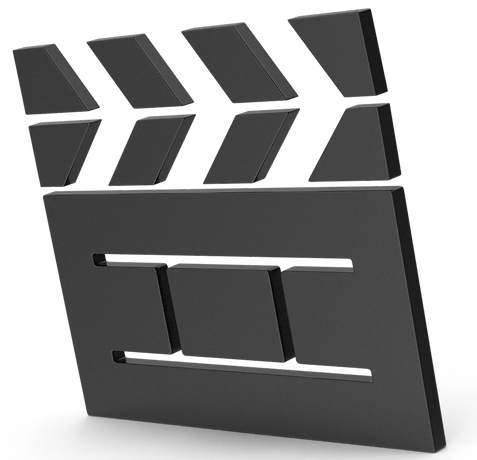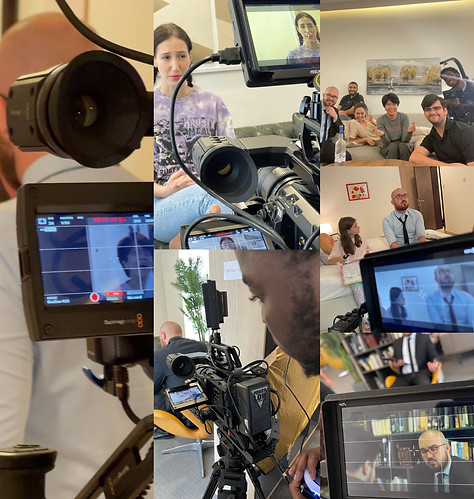
SUCCOURER SHORT FILM
MUHAMMED-RAFIQ

01
CONCEPT DEVELOPMENT
The initial idea for the film was from a scene I saw in the TV series "Seal Team". The scene showed how a psychologist could help a disturbed character express his emotions. Through a similar setting and subject matter, I wanted to create a dramatic piece with a contrasting revelation at a point of resonance, basically, I wanted to give my audience some form of mind-bending experience. I came up with three stories within the same concepts, but only one fitted the most for a short film and could be achieved with a micro-budget.
In order to inform my writing process, I indulged in seeing more movies with similar scenes and research practices in psychology. This will help me develop the main character (the psychologist) as it is crucial for the talent to be able to embody the character's Professional traits. Once the lead character was developed, I went on to develop other characters based on an analysis of the most common issues people who visit psychologists have.

02
DIRECTING/PRODUCTION
Directing this short film was a success though it was quite challenging at first, the Challenges we faced were not exactly related to achieving the intended creative vision. Being the producer also, I was tasked with providing some materials (props &set) that weren’t available until the last minute. This resulted in having to improvise with the set design, hence not realizing the mise-en-scene as envisioned. However, I was able to guide the talents to embody their characters just as I had envisioned. Since we had rehearsed most of the scenes prior to the shooting date, the talent's understanding of their respective characters helped in making the directing process a lot smoother.
Communication with collaborators among the crew was very effective as I briefed every member while setting up. I requested technical reports and feedback from both members of the crew and cast after every shot to ensure that everyone was satisfied with the final coverage or performance, at which point, I observed every member's response to determine the genuineness of their response.
Sometimes I spoke with collaborators privately to better understand their responses. To maintain a smooth working environment, I frequently communicated the errors in our takes generally to keep everyone engaged and provide room for improvements.
I executed multiple technical tasks during the production, being the camera operator on a skeleton crew, I also performed the role of grip, which I performed to my own satisfaction most of the time. There were a few instances where I had to decide to move on from a complicated shot to a simpler shot, hence prioritizing the narrative outcome. I will work on finding a balance between both roles in the future, where I can efficiently compensate my creative vision with my technical skills.


03
PROMOTION STRATERGY
Marketing a short film primarily starts with efforts made by the producers in most cases, as traditional distributors and marketing firms generally specialize in feature-length films. However, there are several established marketing and promotion mediums through which short film producers reach their audience. Considering the said marketing and promotion mediums, here are some marketing strategies I intend to employ in order to reach the desired audience;
-
CREATING A WEBSITE: an IMDB page and web page will be made for people to learn details and give comments about the film.
-
BUILDING AN AUDIENCE: members of the cast and crew will help share the film concept and their involvement with their friends and family to bring expectations. Thus creating an existing audience before the film is finished.
-
SOCIAL MEDIA: social media platforms remain the best medium for engaging the audience using captivating teasers and stills from the final film.
-
FILM FESTIVALS: International film festivals, both online and offline are the best way to reach potential employers or collaborators in the film industry, I will research festivals that often accept films with similar themes, and include subtitles to make the film accessible to a wider audience.
04
AUDIENCE FEEDBACK &PERSONAL REFLECTION

The SUCCOURER short film has generated overall positive feedback so far, from the read-through exercise of the initial script version, I learned that the script was well written and the intended narrative approach was best suited for the theme of the film.
The collaboration process started immediately after I completed the first draft of the script, I collaborated with a Talent community representative to gain access to potential talents who will be willing to work together in the character development and production.
I drafted a new version of the pitch deck, one that best highlights the character traits of the film, which I shared with talents that reached out after I sent out a casting call through the talent community representative. This procedure helped me reach the right people for the role much quicker as I was able to access their level of interest even before we scheduled a meeting.
However, after the roles were sealed and while I was working on scheduling the shooting days based on the availability of the cast, two members of the cast backed out of the project as a result of prior commitments they had, this happened because I was unable to secure a location permit on time and couldn’t confirm the shooting days until it was too late. I will make sure to address factors that may affect a production date and rule them out before the casting process in the future to avoid such situations.
Once the shooting date was confirmed, I created a group where I asked for suggestions and discussed developments in the scripts, wardrobe, and production schedule with the cast. I believe involving the entire cast in certain decision-making processes created a friendly environment that resonated through the production set.
I worked with a 3 man crew, myself, Victor, and Miguel who performed sound recording and AD tasks respectively. Initially, the production process was meant to be executed by a team of 5 collaborators, myself included. While I direct and man the camera, Passa would perform lighting tasks before we roll and help with focus pulling while we roll, Victor will record sound, Aisha will supervise the script and help mark the clips and Nikhil will manage the entire set, corresponding with the cast to ensure safety guidelines are being implemented and timely arrival of everyone. However, the production team was cut down to only 2 members within 24 hours before the first shooting day, as a result of the unavailability and indisposition of some crew members, I was able to redesignate several roles so as to proceed as scheduled by prioritizing some production tasks while expunging others. I made certain compromises on the first day/location, where I relied on only natural lighting and readjusted my frame in order to use a more compact set as the intended set design could no longer be achieved.
Collaborators among both crew and cast executed their roles quite effectively and the production went on very smoothly, even more than expected. Miguel picked up the focus puller task immediately after I demonstrated how to use the equipment and was able to execute the task efficiently. we developed a queuing technique that helped us work synchronically while executing shots. Victor often gave reports after every take that helped me decide on the best takes, he paid very close attention to every aspect of the sound he captured, spotting noise, reverb, or unclarity in the recorded audio and notified the team whenever there is a need for a retake while suggesting ways to achieve better audio quality.
I was able to manage every aspect of the production despite the shortage of crew members, however, this resulted in stress and fatigue on my end. I have learned that I tend to make mistakes when stressed and under pressure, but because I scheduled the production with enough time and breaks to give the cast and crew some breathing space, the pressure factor was avoided.
Technically, I made some errors that may have been well avoided if we had more crew members, or had access to the equipment required for executing certain shots. I had initially planned to rent a camera support and stabilization system that will help reduce having to use the camera in a handheld position, while still introducing a desired floating scene feel that can be achieved in a handheld position. However, I was unable to get access to the equipment due to availability and an unforeseen service fee required to get a replacement included in the rental process. Eventually, I executed the shots in a handheld position, and having to handle the camera and pull focus simultaneously introduced unwanted shakes in some of the shots and made tracking and dolly shots almost impossible. In the future, I will ensure that rental processes are not just initiated at the very start of the preproduction phase but are paid for in order to secure access to the rental equipment.
Personally, I believe that the production went on as best as it could given the events that occurred very close to the shooting date and other factors that depended on third parties.
However, the collaboration process and strategy were effective for the type of creative media production. Being able to produce a short film with a skeleton crew and cast that were willing to participate in an unpaid project could only have been possible because every party considered it as a collaboration. one where both parties are faced with challenges that test their skills and help them realize areas for improvement and presents an opportunity to gain more experience working as a unit in order to achieve a defined goal. The collaborative process served as a learning process, portfolio development, and networking opportunity for all the parties involved.
